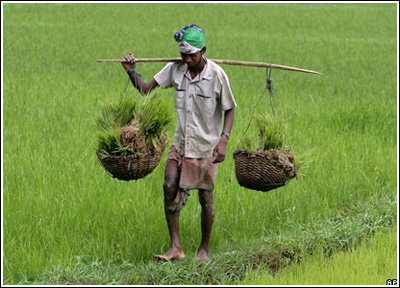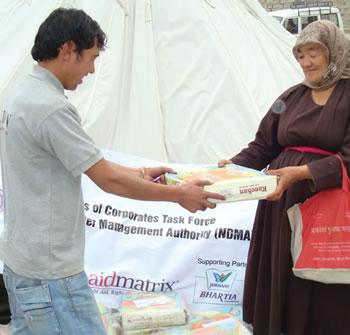India
Bamboo charcoal as a natural Water Filter - An indigenous rural application
Posted on 16 Jul, 2011 07:24 PMGuest post: Shwetha Kamath (India Water Portal Volunteer)
About 74 per cent of India's total population, currently about 1.25 billion, live in rural areas. More than one third of the water available to them is not potable. In a grim reminder that poor quality of drinking water leads to serious health problems, India has admitted that about 180,000 rural populated areas are afflicted by diseases which are caused due to impure, toxic organic and inorganic substances including tri-halo methane, chlorine, etc. Some states have reported multiple contaminations in drinking water and there is no doubt that the current water situation in India will get much, much worse unless suitable solutions are sought. Most existing purification methods not only remove the impurities but drain out the essential minerals as well. Moreover, they are expensive and require extensive maintenance. Thus a natural filter comprising of bamboo, gravel, pebble and other locally available natural adsorbents is a great alternative to carry out water purification. What makes this filter unique is the use of bamboo charcoal which is not commonly used in any filter designed for domestic purposes.
Why India's 'growth' focus is ignoring the food access question - Article from Infochange India
Posted on 14 Jul, 2011 11:41 AMArticle and Image courtesy: Infochange India
Author: Rahul Goswami
Celebrating the fact that per capita agricultural income is increasing faster than overall per capita income, the government is targeting 4% growth in agriculture in the Twelfth Plan period. But this is a rosy view that does not stand up to scrutiny.

Corporate Disaster Recovery Network bags PC Quest Best IT Implementation Award 2011 for maximum social impact - Article from PC Quest
Posted on 14 Jul, 2011 10:45 AMArticle and Image courtesy: PC Quest
Auhtor: Shumpy Saini
An online portal that provides the right aid and resources to the right people at the right time when disaster strikes.
 With a belief that those who serve people in need shouldn't have to sacrifice on the tools they use, Aidmatrix Foundation came up with CDRN. It's an online portal that helps bring people together with the use of applications for supply-chain management, volunteer management and fund raising. People can enter their needs, donations, products or supplies into the CDRN system, which is in turn accessed by a nationwide network of relief agencies, corporates, state Governments, federations, and PSUs. It allows donors to provide discounted pricing offers as well as donations directly to various relief agencies by viewing needs posted on the system.
With a belief that those who serve people in need shouldn't have to sacrifice on the tools they use, Aidmatrix Foundation came up with CDRN. It's an online portal that helps bring people together with the use of applications for supply-chain management, volunteer management and fund raising. People can enter their needs, donations, products or supplies into the CDRN system, which is in turn accessed by a nationwide network of relief agencies, corporates, state Governments, federations, and PSUs. It allows donors to provide discounted pricing offers as well as donations directly to various relief agencies by viewing needs posted on the system.
Prospects and policy challenges in the Twelfth Plan - A comment on the risks in Economic and Political Weekly
Posted on 14 Jul, 2011 08:57 AMDr. Y Venugopal Reddy begins by stating that the article offers a comprehensive, succinct and summary overview of the subject and is very useful as reference material. However, there is, a vital element that is missing in the analysis, namely, a discussion of the risks to the economy and economic agents. An enumeration and discussion of the many risks must be taken into account while framing the Twelfth Plan.
Prospects and policy challenges in the Twelfth Plan: A special article by Montek Singh Ahluwalia in EPW
Posted on 14 Jul, 2011 08:55 AMThe year 2011-12 is the last year of the Eleventh Plan and this is therefore an appropriate time to review what has been achieved with a view to identify weaknesses in the strategy that need to be corrected, and also identify new challenges that may require new initiatives. The paper is presented in the hope of spurring a broader discussion on these issues.
Groundwater - Nation’s water lifeline suffering multiple crisis – A presentation by Himanshu Thakker
Posted on 13 Jul, 2011 09:41 PM
This has been followed with a discussion on issues of quality and quantity. The importance of groundwater in India’s water sector is highlighted. The presentation discusses how an increase in overall irrigated area, in spite of decrease in contribution from big dam irrigation projects was possible due to the steep increase in groundwater irrigated areas.
Protect soil and water by Zero Budget Natural Farming
Posted on 12 Jul, 2011 04:12 PM. It protects and nourishes the soil. It also saves the water and enriches the ground water reserves.
Download the below attachment to read more
A functional Green Tribunal - Article by Kanchi Kohli in mylaw.net
Posted on 12 Jul, 2011 02:08 PMThe Delhi High Court in its order in C.M. No. 15895/2005 in Writ Petition Number 17682/2005 relating to the National Environment Appellate Authority (“the NEAA”) had vehemently said the following.
 Justice (retd.) N. Venkatachala of the Supreme Court headed the NEAA for three years
Justice (retd.) N. Venkatachala of the Supreme Court headed the NEAA for three years
The image above and on article thumbnail is from the website of the Supreme Court of India
“The numerous orders passed by this court in the past three years reflect both the concern of the court and the considerable restraint exercised by it in refraining from proceeding against the concerned officials for disobeying its binding orders. However, the government has failed to take satisfactory steps to address the concern expressed by this court. It has failed to comply with the court's orders and has left it with no choice but to issue further mandatory directions to ensure that the legislative mandate contained in the NEAA Act is not frustrated by executive apathy. The government has to be made accountable in law for its disobedience of the court's orders…”
The Department of Land Resources under the Ministry of Rural Development in consultations with the National Rainfed Area Authority issue revised guidelines on the inclusion of forest areas under the Integrated Wasteland Management Program - PIB release
Posted on 12 Jul, 2011 10:41 AMArticle courtesy: Press Information Bureau
As per the modifications in Para IX of the common guidelines for Watershed Development Projects, 2008, in the multi tier approach, it has been proposed that there would be a multi tier ridge to valley sequenced approach which should be adopted towards the implementation of the Watershed Development Projects.
National voluntary guidelines on social, environmental & economic responsibilities of business released
Posted on 11 Jul, 2011 01:41 PMHe said the beginning of industrialization marked the transition from merchant charity to industrial philanthropy in India which was more secular, more inclusive in terms of caste, creed and community and more oriented to bringing progress to society through western style modern institutions.
Apart from making political donations for the freedom struggle, business fraternity also contributed towards many of the social and cultural causes. Mahatma Gandhi expounded the theory of trusteeship of wealth. Influenced by his teachings, many businessmen contributed for the cause of removal of untouchability, women’s emancipation and rural reconstruction.